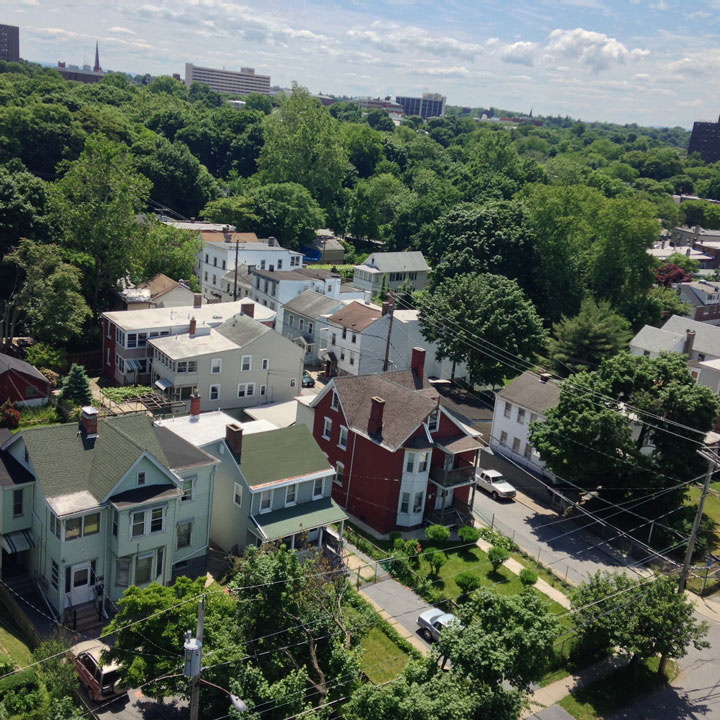
Mid-Hudson
Build on the Hudson Valley’s urban and natural heritage
The Mid-Hudson Valley is one of the the most geographically diverse parts of the tri-state region, with the Catskill peaks, rural landscapes, villages and hamlets, and cities from Yonkers to Kingston. The seven-county area includes both very affluent suburban towns and much poorer communities, in both urban and rural settings. While some places in the Mid-Hudson Valley are losing population, others are expanding with new tracts of single-family homes.
The Mid-Hudson Valley is connected by an extraordinary river estuary renowned for its natural beauty, protected watersheds, and productive farmland. Yet development continues to overtake open space, threatening the environment of the entire region as well as the agricultural and recreation jobs that are critical to the Hudson Valley economy.
This landscape is essential to the region’s ecology, as it protects much of the drinking water supply and absorbs heat-producing greenhouse gases—which are particularly important functions in the era of climate change. Sea-level rise (which affects the Hudson River), Intense storms, and rising temperatures threaten the passenger and freight railroad lines that run along either side of the river, agriculture, and the tourist-based economy.
Over the last decade, the Mid-Hudson Valley economy has slowed dramatically. From 1996–2006, the area added 108,000 jobs—a 14 percent increase, and a faster rate of growth than any other part of the tri-state region. But in the following decade, the area gained only 25,000 jobs, or just 3 percent. (By comparison, jobs grew by 18 percent in New York City and 6 percent on Long Island in that same period.) The manufacturing that drove much of Mid-hudson Valley economy in previous decades has largely gone, replaced by industries such as healthcare, education, tourism, and goods distribution.
The future of the Mid-Hudson Valley depends on linking its many natural, human, and historical assets to a new technology-driven economy. The Fourth Regional Plan recommends ways to allow these communities to capitalize on their high quality of life, relative affordability, and access to rail transportation to take advantage of changing demographics, changing work patterns (such as flexible hours and working remotely), and shared transportation services to connect to New York City and other job centers.
The plan supports Metro-North’s initiative to connect the New Haven Line to Penn Station. It also includes a proposal to build new rail tunnels under the Hudson River to allow for reactivation of passenger rail service in Rockland and Orange counties.
Express bus service across the Mario Cuomo (Tappan Zee) Bridge would connect job centers, residential communities, and commuter rail lines in Westchester and Rockland counties. Highway congestion would be reduced by using technology to remove bottlenecks and manage traffic, and tolling that would vary by time of day and level of traffic.
Connecting communities in the Mid-Hudson with affordable, high-speed internet service is key to ensuring that they are tied to jobs throughout the region, and opening up new opportunities for isolated, low-income communities.
Even with these improvements, achieving a strong and equitable economy won’t be possible without expanding housing choices for low-, moderate-, and middle-income residents, and ensuring everyone has access to affordable homes close to good schools and jobs.
Recommendations in the Fourth Plan would support stronger state assistance and requirements for all municipalities to permit affordable, multifamily housing near transit, and encourage two- and three-family homes in areas where environmental conditions don’t permit greater densities. Strengthening fair-housing laws and protecting residents from displacement would benefit all residents.
Proposals in the Fourth Regional Plan build on both long-standing and recent efforts by local residents, organizations, and public sector leaders to preserve and enhance its natural assets—forests, farmland, wetlands, and waterways—for tourism, agriculture, and resilience. Funding for open-space preservation should be increased and also used more strategically, with a focus on the places that can best mitigate the effects of climate change, support local economies, and strengthen the food-supply chain that stretches from Hudson Valley farms to New York City green markets.
The proposed 1,620-mile regional trail network would build on existing and planned trails in the Mid-Hudson Valley, including the Appalachian Trail, the Empire State Trail, and the Long Path, putting far more of the region’s residents within walking or transit distance of these natural landscapes.